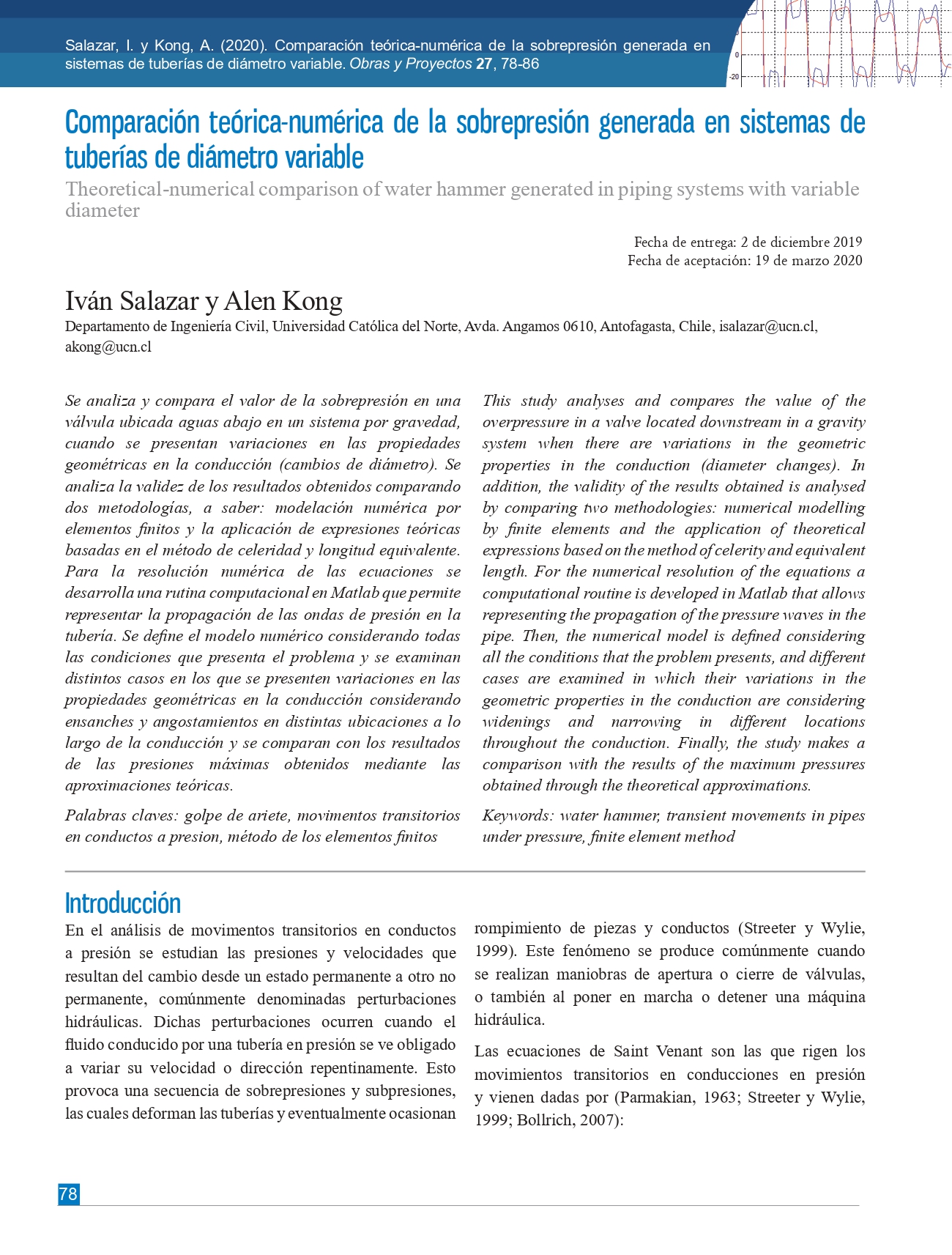Theoretical-numerical comparison of water hammer generated in piping systems with variable diameter
DOI:
https://doi.org/10.4067/S0718-28132020000100078Keywords:
water hammer, transient movements in pipes under pressure, finite element methodAbstract
This study analyses and compares the value of the overpressure in a valve located downstream in a gravity system when there are variations in the geometric properties in the conduction (diameter changes). In addition, the validity of the results obtained is analysed by comparing two methodologies: numerical modelling by finite elements and the application of theoretical expressions based on the method of celerity and equivalent length. For the numerical resolution of the equations a computational routine is developed in Matlab that allows representing the propagation of the pressure waves in the pipe. Then, the numerical model is defined considering all the conditions that the problem presents, and different cases are examined in which their variations in the geometric properties in the conduction are considering widenings and narrowing in different locations throughout the conduction. Finally, the study makes a comparison with the results of the maximum pressures obtained through the theoretical approximations.
References
Abreu, J.M., Guarga, R. e Izquierdo, J. (eds.) (1995). Transitorios y oscilaciones en sistemas hidráulicos a presión. Unidad Docente Mecánica de Fluidos, Universidad Politécnica de Valencia, España.
Allievi, L. (1903). Teoria generale del moto perturbato dell’acqua nei tubi in pressione (colpo d’ariete). Associazione Elettrotecnica Italiana, Roma, Italia.
Bollrich, G. (2007). Technische Hydromechanik I. 6. Auflage. Huss-Medien GmbH, Berlin, Germany.
Chung, J. and Hulbert, G.M. (1993). A time integration algorithm for structural dynamics with improved numerical dissipation: the generalized-α method. Journal of Applied Mechanics 60(2), 371–375. https://doi.org/10.1115/1.2900803
Hughes, T.J.R. (1987). The finite element method: linear static and dynamics finite element analysis. Prentice-Hall, New Jersey, USA.
Jansen, K.E., Whiting, C.H. and Hulbert, G.M. (2000). A generalized-α method for integrating the filtered Navier-Stokes equations with a stabilized finite element method. Computer Methods in Applied Mechanics and Engineering 190(3-4), 305–319. https://doi.org/10.1016/S0045-7825(00)00203-6
Kong, A. y Salazar, I. (2017). Sobre la influencia de la heterogeneidad de material en el cálculo de la sobrepresión en ductos en presión. Ingeniería Innova 13, 1-16.
Parmakian, J. (1963). Waterhammer analysis. Dover Publications, New York, USA.
Salazar, I., Köngeter, J. y Covarrubias, A. (2011). El método de los elementos finitos aplicados a problemas de mecánica de fluidos. Revista de Ingeniería Innova 1, 18-27.
Streeter, V.L. y Wylie, E.B. (1999). Mecánica de fluidos. 8ª ed., McGraw-Hill, México.
Twyman, J. (2019). Análisis transiente de la demanda de agua uniformemente distribuida. Obras y Proyectos 26, 43-50. https://doi.org/10.4067/S0718-28132019000200043
Twyman, J. (2018). Transient flow analysis using the method of characteristics MOC with five-point interpolation scheme. Obras y Proyectos 24, 62-70. https://doi.org/10.4067/s0718-28132018000200062
Twyman, J. (2016). Wave speed calculation for water hammer analysis. Obras y Proyectos 20, 86-92. https://doi.org/10.4067/S0718-28132016000200007
Videla, D. y Salazar, I. (2010). Comparación del método de Crank Nicholson y α-generalizado aplicados a la ecuación de flujo de aguas subterráneas. Obras y Proyectos 7, 51-56.
Zienkiewicz, O. y Taylor, R. (2000). El método de los elementos finitos. 5ª edición CIMNE, Barcelona, España.

Downloads
Published
Issue
Section
License
Copyright (c) 2020 Universidad Católica de la Santísima Concepción

This work is licensed under a Creative Commons Attribution-NonCommercial 4.0 International License.







